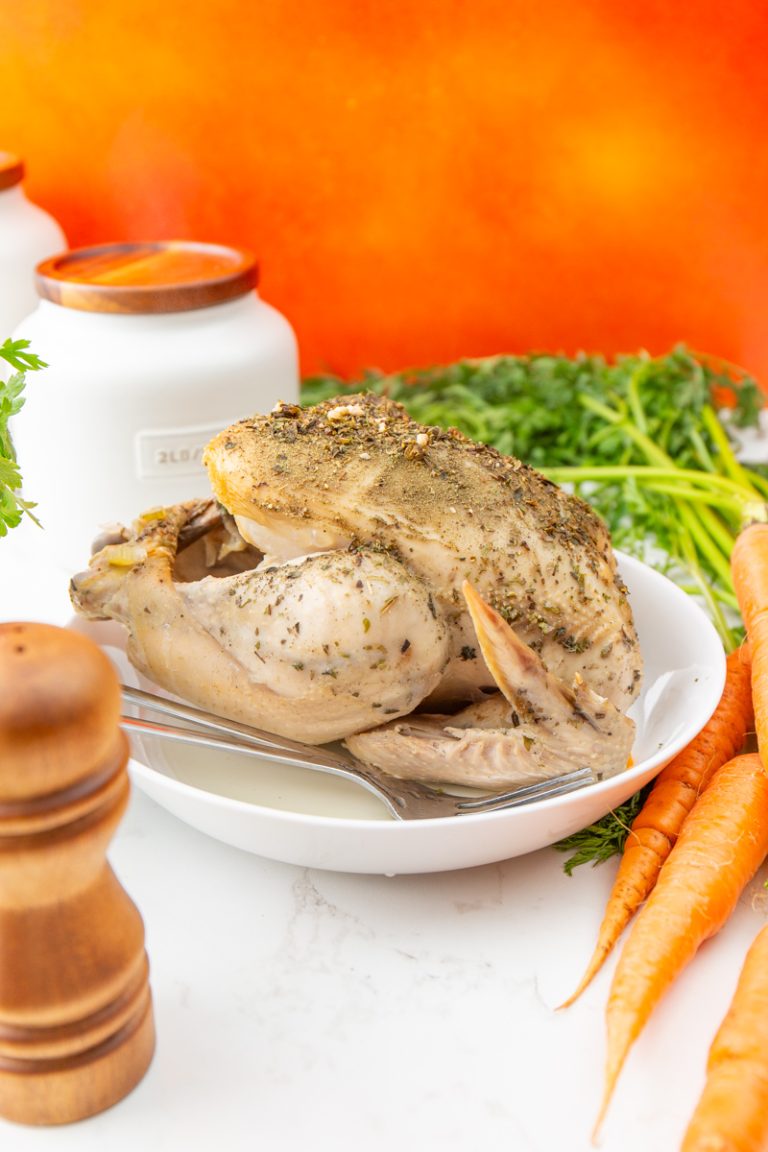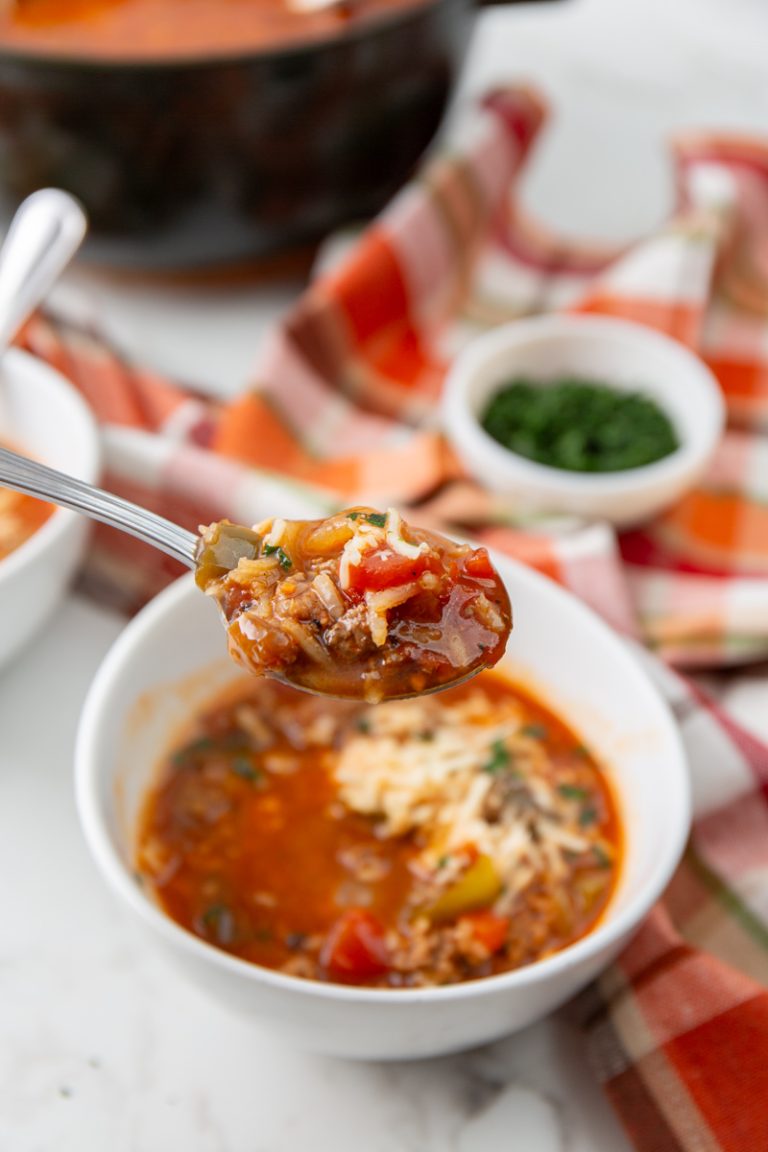Slow Cooker Chicken Stock
This post contains links to affiliate websites, such as Amazon, and we receive an affiliate commission for any purchases made by you using these links. We appreciate your support!
Slow Cooker Chicken Stock is a staple for any kitchen and is so easy to make on your own! All you need is a chicken carcass leftover from any meal and you can make delicious chicken broth absolutely free.


Today’s Focus: Food Scraps
Food waste is not only a pressing global issue, but can also impact a family’s budget. Creating your own chicken stock is a small yet impactful step towards reducing food waste. By transforming kitchen scraps into a rich and delicious stock, you’re helping combat the larger problem of food waste in your household.
Benefits to Homemade Chicken Stock
Making your own crock pot chicken stock is incredibly cost-effective. Instead of purchasing pre-made stock from the store, you can utilize leftover chicken bones and carcasses that might otherwise go to waste. This frugal approach not only saves you money but also maximizes the value of your ingredients.
The depth of flavor achieved in homemade chicken stock is unmatched. You have full control over the seasonings and ingredients, resulting in a stock that’s tailor-made to your taste preferences. The rich, aromatic, and savory qualities of homemade stock can elevate your soups, stews, sauces, and gravies to a whole new level.
Making chicken stock at home is also such an easy process! It doesn’t require a culinary degree or fancy equipment. With a simple slow cooker or stockpot, water, chicken scraps, and some aromatic vegetables and herbs (if you’d like), you can whip up a batch effortlessly.
Ingredients Needed

Exact measurements can be found in the printable recipe card below.
Various Ways to Store Homemade Chicken Stock
- Short-Term Storage: For immediate use within a few days, keep the chicken stock in an airtight container or covered pot in the refrigerator. Use it within 3-4 days.
- Ice Cube Trays: Pour the stock into ice cube trays. Once frozen, transfer the stock cubes to a freezer bag. This is ideal for small portions or when you need a little stock for things like deglazing the pan.
- Zip-Top Bags: Pour cooled stock into quart-sized zip-top bags. Lay them flat in the freezer for easy storage and quick thawing. Tip: some will store the bags in a pot until frozen, that way you can transfer frozen stock to a slightly bigger pot when ready to use. It’s more difficult with stock that’s been frozen flat.
- Vacuum-Sealed Bags or Tupperware: Use a vacuum sealer to create airtight packages for your chicken stock. This method prolongs storage and minimizes freezer burn.
- Pressure Canning and Sealing: Pressure cook the stock and store it in canning jars with proper sealing. This offers a compromise between canning and refrigeration. Make the chicken stock shelf stable.
- Dehydrated Stock Powder: Reduce your chicken stock until it’s a thick gel-like consistency. Spread it thinly on dehydrator trays or use a low-temperature oven. Once dried, grind it into a powder. Store the powder in an airtight container. To use, rehydrate with hot water. For more information on this technique check out Little House Living.
- Reduce and Freeze: Reduce the stock by half or more to concentrate its flavor. Freeze the concentrated stock in small portions. When needed, dilute it with water or use it as a flavor-rich base.

Freezer safe containers
Freezer-safe containers are essential for preserving the quality and flavor of your food when freezing. Here’s a rundown of some common freezer-safe container options:
- Rigid Plastic Containers: These are specifically designed for freezer use. Look for containers labeled as “freezer-safe” or “food storage for freezer.” They come in various sizes and are reusable.
- Plastic Freezer Bags: Heavy-duty plastic freezer bags are excellent for storing liquid-based items like soups, stocks, and sauces. Double-bagging can provide extra protection against freezer burn.
- Tempered Glass Containers: These containers are durable and can go from the freezer to the oven or microwave. Look for those with airtight, leak-proof lids.
- Mason Jars: Regular glass mason jars are suitable for freezing, but be sure to leave enough headspace to accommodate expansion as liquids freeze.
- Vacuum-Sealed Bags: Vacuum sealing removes air, reducing the risk of freezer burn. Use a vacuum sealer to create custom-sized bags for various food items.
- Silicone Freezer Containers: These are flexible, collapsible containers that save space when not in use. They are suitable for both dry and liquid items.
- Ice Cube Trays: Ideal for freezing small portions of liquids like broth, sauces, or pesto. Once frozen, transfer the cubes to a freezer bag for easy storage.
Instructions
This is an overview of the instructions. For complete directions, scroll down to the bottom.
- Add any chicken scraps, vegetable scraps, and seasoning you’d like to a slow cooker or stock pot. Add water, cover, and cook on low for 8 hours.
- Strain and jar while hot, or allow to cool to room temperature before freezing.

Other ways to use food scraps
- Food scraps like fruit and vegetable peels, coffee grounds, and eggshells can be composted to create nutrient-rich soil for your garden.
- Save vegetable scraps like onion skins, carrot ends, and herb stems to make flavorful vegetable broth.
- Dried citrus peels, herb cuttings, and flower petals can be used to create natural potpourri.
- Citrus peels soaked in vinegar make an effective homemade cleaner.
- Some vegetable scraps like lettuce, green onions, and celery can be regrown in water, reducing your need to buy new produce.
How to store and love your leftovers
- Refrigerate: Stored in an airtight container, refrigerated homemade chicken stock should be used within 3-4 days.
- Freeze: Once the stock is completely cooled, store in freezer-safe containers for up to 6 months!
- Reheat: Thaw frozen stock in the refrigerator or microwave, then heat gently on the stovetop or in the microwave until hot, avoiding boiling to preserve flavor. Stir well when reheating.
Use this chicken stock to add flavor to soup as well as any pasta or rice dishes!

Want to save money in a truly effortless meal planning method?
Grab the Rescue Meal Planner!
FAQ’s
Yes, you can use chicken carcasses, wings, necks, and backs. Using a mix of these parts enhances flavor.
Absolutely! Leeks, garlic, and parsnips can add depth of flavor. Avoid strong-tasting veggies like cabbage or broccoli.
Chicken stock is made with bones and simmered longer for a richer, more gelatinous liquid. Broth uses meat and is lighter in flavor and texture.
A solid layer of fat will settle to the top of the stock as it cools. Don’t throw this out! This is good stuff and full of nutrients. When you reheat the stock it will incorporate.

What to make with chicken stock
- Mexican Beans and Rice
- Slow Cooker Chicken Pozole
- Crockpot Creamy Poblano Chicken Chowder
- Leftover Turkey Noodle Soup
Hey, if you want to catch all my videos, be sure to subscribe to my YouTube Channel. You’ll be notified each time I share a new video!
If you love this recipe, please leave a ⭐⭐⭐⭐⭐ rating!
Slow Cooker Chicken Stock

Equipment
- 6 quart slow cooker
- mesh strainer
- funnel
- container for stock
Ingredients
- 1 chicken carcass
- 6 cups water
- 2 Tablespoons spices optional
Instructions
- Add any leftover chicken scraps to the slow cooker. Add any seasonings or vegetable scraps like onion, carrots, or celery if desired. Pour the water in. Stir and cover. Cook on low for 8 hours.
- Strain and funnel into your choice of heat-safe container while hot. Allow to cool to room temperature before freezing.






